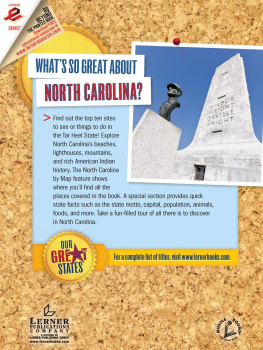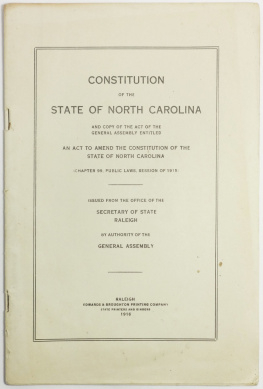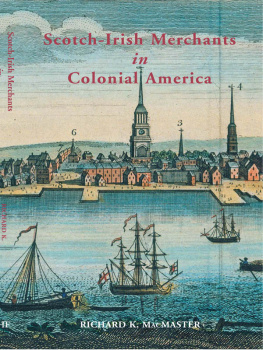PREFACE
T his monograph surveys the changing geography of colonial North Carolina, and may be described as a study in the field of historical geography. The approach used illustrates a current emphasis within that field on the analysis of changing geographies and of forces contributing to change. Recent discussions of the nature of historical geography have helped to dispel earlier confusion and there is no need to redefine the scope and purpose of the field here.
More specifically, the work is intended as a contribution to the understanding of the colonial geography of the Atlantic Seaboard, a large but much neglected subject. What is presented in the following pages represents an attempt to begin the study of the colonial Seaboard by analyzing a segment of it.
During the eighteenth century a large and rapid increase of population took place in North Carolina as settlers spread over much of the land between the coast and the Appalachians. The period emphasized in this work runs from about the middle of the century to the Revolution. The use of a vague phrase to indicate the starting point is deliberate. Rather than fix upon any one year it was decided to adopt a fairly flexible date line and to begin the analysis of particular topics at whatever point in time seemed most appropriate. The outbreak of the Revolutionary War in 1775 provided a convenient and conventional stopping point.
During the time that has elapsed since I first began working on the geography of the colonial Seaboard I have imposed upon the kindness of many persons. I am especially indebted to certain individuals in North Carolina, and among those who helped me with their particular knowledge and made my research and travels in that state one of the most enjoyable phases of the work were the following: Dr. C. C. Crittenden, Mr. D. L. Corbitt, Mr. H. G. Jones, Mr. W. S. Tarlton, and Mrs. Mary Rogers of the North Carolina State Department of Archives and History; Professor Louise Hall of Duke University, and Miss Florence Blakeley, at Duke University Library; the staff of the Moravian Archives in Winston-Salem; Dr. Frank P. Albright (who made my visit to Old Salem enjoyable and instructive); Miss Georgia Faison, at the North Carolina State Library; Professor E. F. Goldston, of North Carolina State of The University of North Carolina at Raleigh; Professor H. T. Lefler, of the University of North Carolina at Chapel Hill; and Professor William P. Cumming of Davidson College. Mr. William S. Powell of the University Library at Chapel Hill, provided continuing assistance in innumerable ways and I gained much from his advice and help. Archival research and field work in North Carolina were facilitated through funds granted by the University of Wisconsin, in the form of a Kemper K. Knapp Graduate Fellowship, and a Travel Award from the Department of Geography.
While I was at the University of Wisconsin, first as a graduate student and then later as a faculty member, I received valuable criticism from members of the Geography and History Departments. Professor Clarence W. Olmstead offered advice and raised pertinent questions during the early phases of the research. To Professor Merrill Jensen I owe a special statement of thanks for his aid on many occasions. Professor Richard Hartshorne generously accepted an extra responsibility and I benefited as a result. Professor Andrew H. Clark was the one upon whom I imposed in the greatest variety of ways; even a protracted transatlantic correspondence did not affect his ability to stimulate and to furnish provocative criticism. I have learned much from him.
Friends and colleagues elsewhere, and especially those at San Fernando Valley State College, have helped in various ways. Most of all, I am indebted to Professor Joseph A. Ernst, for willingly undertaking the laborious task of reading the first and roughest draft and for his perceptive criticism on many subsequent occasions. Professor William Pattison has had much to do with my commitment to American studies; I am grateful for his critical interest, expressed initially as a tutor (at University College London) and subsequently as a colleague and friend in the Department of Geography at San Fernando Valley State College. Another friend with an enthusiastic and critical interest in the geography of colonial America, Mr. James Lemon, made helpful suggestions after reading an early version of the manuscript.
Several cartographers and typists have assisted me with their special skills. Most of the original maps were drawn by Miss Phyllis Graebel and Mr. Paul E. Sisco, Jr., and their conscientious help was invaluable. I am also very grateful to Miss Jerrilyn Schnepple, who competently disposed of the final typing and proofreading. Finally, in preparing the manuscript for publication I have enjoyed working with the patient and experienced staff of the University of North Carolina Press. For those errors that survive, despite the careful help of readers, cartographers, and typists, I alone am responsible.
My wife Gerda died a few weeks after the manuscript for this book was completed. I am grateful for what she invested in my work.
Harry Roy Merrens
Northridge, California
February 1, 1964
CHAPTER I . A SUMMARY VIEW OF THE EASTERN SEABOARD IN 1750
T he first permanent English settlement on the Atlantic Seaboard was begun in 1607. During the following century and a half the process of colonization resulted in the emergence of the thirteen colonies that were subsequently to join together to form the United States. What had begun as a handful of settlers insecurely seated on a forbidding neck of land had become, by 1750, a more or less continuous belt of settlement stretching for a distance of over 1,000 miles, and containing about 1,171,000 inhabitants.
Each one of the thirteen colonies developed its own marked individuality and its own internal diversity. The distinctiveness of the colony of North Carolina is the chief subject of the chapters that follow. To place its unique qualities in an appropriate perspective it is necessary first to survey the geography of the other twelve colonies at the middle of the eighteenth century. Traditionally, historians have distinguished between the New England, Middle, and Southern colonies, a division which will serve as a suitable framework for this introductory survey of the geography of the colonial scene in 1750.






